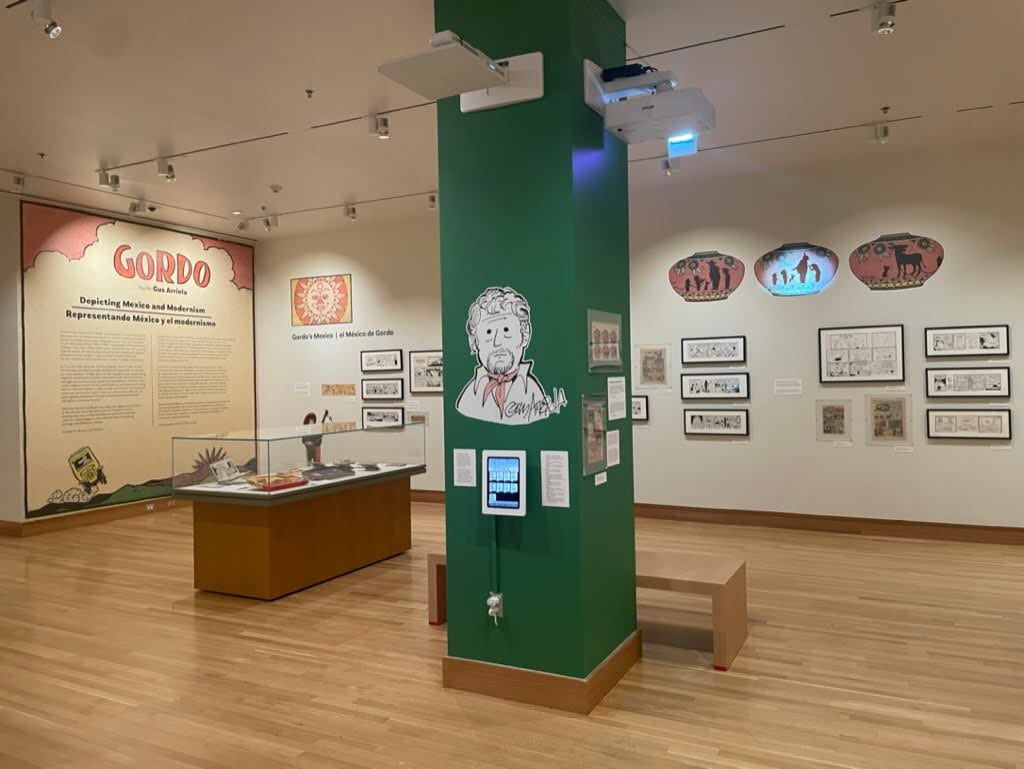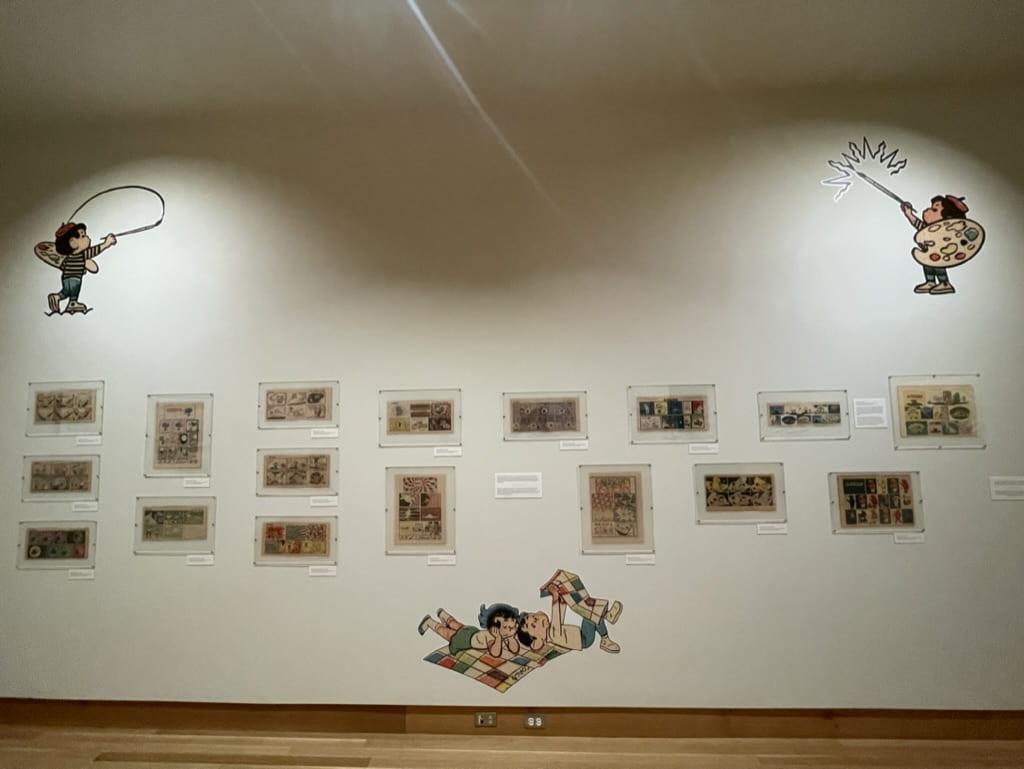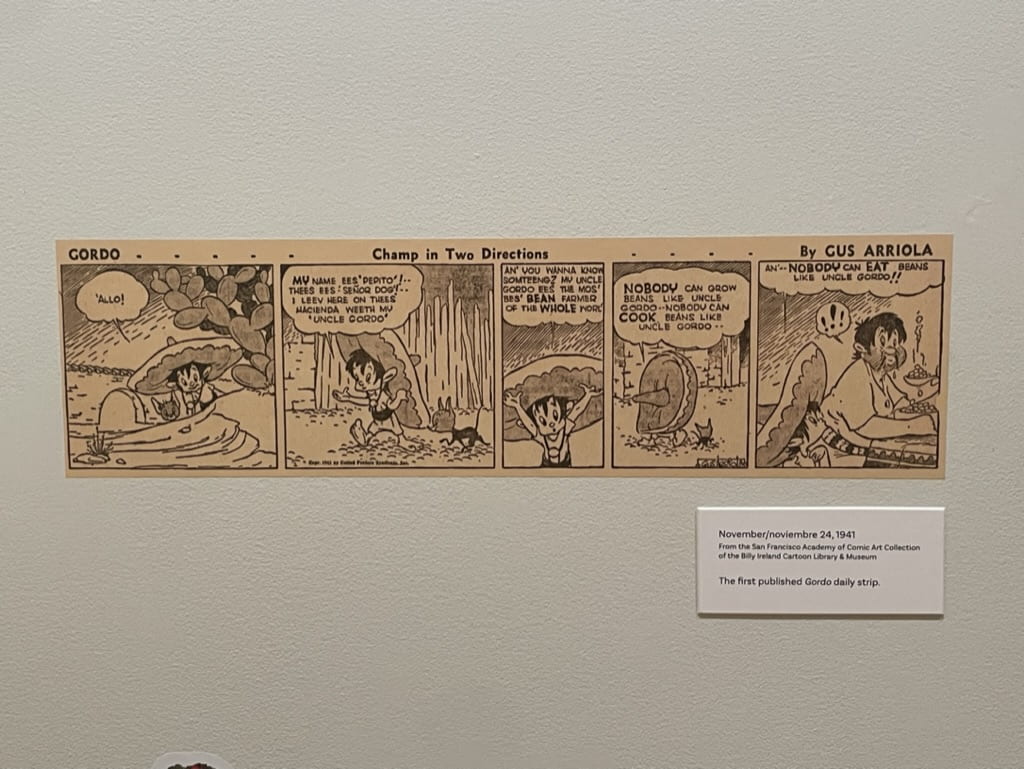
“Depicting Mexico and Modernism: Gordo by Gus Arriola,” an exhibit paying homage to Latino-American cartoonist Gustavo “Gus” Arriola, is currently on view at the Billy Ireland Cartoon Library & Museum. Credit: Raghav Raj | Lantern Reporter
On Dec. 13, 2023, Ohio State’s Billy Ireland Cartoon Library & Museum began housing an exhibit on prolific Latino-American cartoonist Gustavo “Gus” Arriola and his long-running comic strip, titled “Gordo.”
Called “Depicting Mexico and Modernism: Gordo by Gus Arriola,” the exhibit will continue charting the evolution of Arriola’s cartoon strip, which ran from 1941 to 1985, until May 5. At its peak of popularity, “Gordo” was featured in 270 syndicated newspapers, exhibit curator Nhora Luciá Serrano said.
“When you entered ‘Gordo,’ you entered Mexico,” Serrano, also a director of learning and research services at Hamilton College in Clinton, New York, said. “You entered that world, you entered Mexican culture. It really was one of the earliest Latinx characters made specifically for us.”

A gallery wall seen in the “Depicting Mexico and Modernism: Gordo by Gus Arriola” exhibit at the Billy Ireland Cartoon Library & Museum. Credit: Raghav Raj | Lantern Reporter
“Gordo” initially reflected stereotypical depictions of Mexicans in American media, Serrano said. Specifically, she said the main character — named Gordo Salazar Lopez — was depicted as a lazy Mexican farmer who slept in a hammock, wore a sombrero and spoke broken English.
Serrano said the character ultimately evolved into a bus-driving tour guide, while the broader story presented Mexico’s distinct culture and history via inspiration from the country’s modernist artwork and storytelling.
“Gus realized that he was offering something stereotypical, and he didn’t want to do that, so he made the transition,” Serrano said. “As a bus driver, he could be an ambassador and showcase a lot of what’s going on in Mexico in his stories.”
“Depicting Mexico and Modernism: Gordo by Gus Arriola” displays 165 items, museum coordinator Anne Drozd said. She said these objects include 85 “Gordo” strips pulled from the museum’s archives, 35 of Arriola’s original drawings, books, photos and a ceramic bean pot — inspired by a recipe for “beans weeth cheese” published with certain “Gordo” comics — distinctly embossed with the cartoonist’s artwork.
Serrano started developing the idea for an exhibit built around Arriola’s work in 2018. At the time, she was editing an anthology called “Immigrants and Comics: Graphic Spaces of Remembrance, Transaction, and Mimesis.”

A “Gordo” comic strip, as seen in the “Depicting Mexico and Modernism: Gordo by Gus Arriola” exhibit at the Billy Ireland Cartoon Library & Museum. Credit: Raghav Raj | Lantern Reporter
“The exhibit is a wonderful opportunity to showcase, obviously, the wonderful collections that the Billy Ireland has,” she said. “But it’s also to showcase the fact that the history of American comics and cartoons includes ethnic cartoonists like Gus Arriola.”
The exhibit features object labels in both English and Spanish, all of which were personally translated by Serrano. She said the exhibit’s bilingual nature highlights Arriola’s frequent use of Spanish in “Gordo” — the cartoon introduced now-common terms like “hasta la vista,” “amigo” and “piñata” to the general American populace — and ensures the exhibit is more accessible for the Latinx community.
“I wanted the Latinx community not to be hindered by English labels so they could see, read and understand the history of one of their own,” Serrano said.
For Hector Cantú, creator of the Latino-American comic strip “Baldo,” Arriola’s impact is defined by the barriers he smashed for other cartoonists of color.
“In Gus’s time, the comic book pages had been a very homogenous world where you were more likely to see talking animals than people of color,” Cantú said. “So Gus was one of the first to bring this different element to the page, to put ‘Gordo’ next to ‘Dick Tracy’ and ‘Peanuts.’ He opened the pathways for cartoonists like me to come along.”
Cantú, who collaborated with Arriola and maintained contact with the cartoonist until his death in 2008, said the evolution of “Gordo” was a testament to Arriola’s ability to write and develop dynamic characters.
“When ‘Gordo’ started, it was this creation of the 1940s, and it was stereotypical because it’s what people expected,” Cantú said. “But Gus knew that couldn’t last forever. He knew his characters had to grow and evolve, and by the time the strip ended, Gordo was basically a different character. It was always admirable to me how he played with people’s expectations.”
A collector of “Gordo” comics, Cantú contributed some personally owned strips to the exhibit and spoke at its public reception ceremony Jan. 20.
“There are very few comics that impact how people think about things,” Cantú said. “Gus had people thinking about Mexican culture, about your neighbors, about what they brought to the table, the words that they were using, about the language they were using. That’s where Gus broke that ground.”
![Ohio Gov. Mike DeWine signed Senate Bill 1 — a higher education overhaul bill — into law Friday. [Ohio Gov. Mike DeWine speaks at the State of the State address in Columbus. Credit: Joshua Gunter via TNS]](https://www.thelantern.com/files/2025/03/20250204-AMX-US-NEWS-DEWINE-BUDGET-INCREASES-TAXES-FOR-1-PLD-384x253.jpg)

